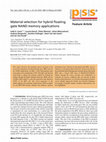Papers by Johan Meersschaut
ACS Applied Electronic Materials
Layered transition-metal dichalcogenides such as MoS2 or WS2 are interesting materials for the in... more Layered transition-metal dichalcogenides such as MoS2 or WS2 are interesting materials for the integration in future transistor channels, photodetectors, or sensors due to their intrinsic bandgap. The plasma-surface interaction of selected plasma effects on these materials was investigated to provide fundamental understanding of the interactions and to derive concepts for a targeted material modification.

ACS Applied Materials & Interfaces, 2021
As critical dimensions in integrated circuits continue to shrink, the lithography-based alignment... more As critical dimensions in integrated circuits continue to shrink, the lithography-based alignment of adjacent patterned layers becomes more challenging. Area-selective atomic layer deposition (ALD) allows circumventing the alignment issue by exploiting the chemical contrast of the exposed surfaces. In this work, we investigate the selective deposition of TiO2 by plasma halogenation of amorphous carbon (a-C:H) acting as a growth-inhibiting layer. On a-C:H, a CF4 or Cl2 plasma forms a thin halogenated layer that suppresses the growth of TiO2, while nucleation remains unaffected on plasma-treated SiO2. The same halogenating plasmas preferentially etch TiO2 nuclei over films and thus enable the restoration of the halogenated surface of amorphous carbon. By embedding the intermediate plasma treatments in the ALD TiO2 sequence, an 8 nm TiO2 layer could be deposited with a selectivity of 0.998. The application of the cyclic process on a 60 nm half-pitch line pattern resulted in the defect-free deposition of TiO2 at the bottom of the trenches. Cyclic fluorination demonstrated better growth inhibition compared to chlorination due to more efficient defect removal and retention of the favorable surface composition during plasma exposure. While exploring the TiO2 nucleation defects at the limit of detection for conventional elemental analysis techniques (<1 × 1014 at/cm2), we additionally highlight the value of imaging techniques such as atomic force microscopy for understanding defect formation mechanisms and accurately assessing growth selectivity.
Environmental Science & Technology Letters, 2021
Journal of Vacuum Science & Technology A: Vacuum, Surfaces, and Films, 2018
Rutherford backscattering spectrometry is a primary reference method for the quantity of material... more Rutherford backscattering spectrometry is a primary reference method for the quantity of materials, but has a limit-of-detection (LOD) presently at ∼1015 at/cm2 for analyses with traceable accuracy near 1%. A multidetector assembly is demonstrated which increases the count rate without decreasing the signal/noise due to pulse pile-up. A LOD of 6 × 1012 at/cm2 is achieved with the multidetector assembly and applied to quantify the onset of an atomic layer deposition (ALD) process for an in-depth study of the growth selectivity of ALD Ru on a-C:H and on SiCN. Besides, the spectrometer enables <10 min measurements on a Ru layer of 2.7 nm, permitting wafer mapping.
Applied Surface Science, 2019
Chemistry of Materials, 2017
RSC Adv., 2016
Silicon alloying of Cu0.6Te0.4 results in an amorphous material up to temperatures exceeding 400 ... more Silicon alloying of Cu0.6Te0.4 results in an amorphous material up to temperatures exceeding 400 °C with a smooth surface morphology, making it compatible with typical device processing temperatures.

Applied Surface Science, 2016
Abstract The epitaxial growth of Si layers on Si substrates in the presence of O atoms is general... more Abstract The epitaxial growth of Si layers on Si substrates in the presence of O atoms is generally considered a challenge, as O atoms degrade the epitaxial quality by generating defects. Here, we investigate the growth mechanisms for Si epitaxy on O atomic layers (ALs) with different O-contents and structures. O ALs are deposited by ozone (O3) or oxygen (O2) exposure on H-terminated Si at 50 °C and 300 °C respectively. Epitaxial Si is deposited by chemical vapor deposition using silane (SiH4) at 500 °C. After O3 exposure, the O atoms are uniformly distributed in Si-Si dimer/back bonds. This O layer still allows epitaxial seeding of Si. The epitaxial quality is enhanced by lowering the surface distortions due to O atoms and by decreasing the arrival rate of SiH4 reactants, allowing more time for surface diffusion. After O2 exposure, the O atoms are present in the form of SiOx clusters. Regions of hydrogen-terminated Si remain present between the SiOx clusters. The epitaxial seeding of Si in these structures is realized on H-Si regions, and an epitaxial layer grows by a lateral overgrowth mechanism. A breakdown in the epitaxial ordering occurs at a critical Si thickness, presumably by accumulation of surface roughness.

physica status solidi (a), 2016
This article discusses the materials aspects involved in the successful integration of hybrid flo... more This article discusses the materials aspects involved in the successful integration of hybrid floating gate (HFG) devices for NAND applications. In HFG, a Si(n type)\metal(p type) stack replaces the standard poly‐Si FG. The high work function metal helps to enlarge the program window by limiting the leakage through the high‐k intergate dielectric (IGD); the use of high‐k IGD enables to scale the equivalent oxide thickness (EOT) of the HFG cell. Our recent progresses in the understanding of the materials characteristics (IGD crystallinity and HFG‐IGD thermal stability) that influence memory performance have allowed to demonstrate that HFG can be a solution to scale planar flash beyond the 20 nm node with the best preferable hybrid floating gate structure being a Ru‐based HFG and a 3‐layers IGD stack of HfAlO\Al2O3\HfAlO. Indeed, through the correct selection and combination of materials for process conditions that are relevant in flash memory fabrication flows, we will show that prog...

ECS Journal of Solid State Science and Technology, 2012
ABSTRACT Vanadium oxide (VO2) thin films were prepared by atomic layer deposition using TEMAV (te... more ABSTRACT Vanadium oxide (VO2) thin films were prepared by atomic layer deposition using TEMAV (tetrakis[ethylmethylamido]vanadium) precursor and ozone as the reactant gas. Study on the precursor as well as oxidizer doses and temperature dependence showed none of them exhibited the characteristics of ideal ALD. The VO2 phase formation pathways, its process window, and surface roughness are found to be sensitive to the anneal conditions applied and the substrate used. The VO2 morphology on Al2O3 was found to be island-like whereas on Si/SiO2 either a nano particle formation or a continuous film was obtained. GIXRD demonstrated the VO2 crystallization window to be very narrow on Al2O3 and thick SiO2 while a relatively broad window is obtained on 1 nm SiO2 . A reversible change in sheet resistance was measured with more than three orders of magnitude for a 30 nm film.
MRS Proceedings, 2013
ABSTRACTIn this work, a novel low dielectric constant (low-k) pore sealing approach was engineere... more ABSTRACTIn this work, a novel low dielectric constant (low-k) pore sealing approach was engineered by depositing firstly a sub-2 nm SAMs and then a 3 nm TiN barrier film. The low-k film was pretreated by plasma to introduce hydroxyl groups onto the surface, followed by SAMs deposition. Then a TiN film was deposited from tetrakis(dimethylamino)titanium (TDMAT) via ALD as a dielectric barrier. Penetration of Ti atoms into low-k was measured and used to evaluate the sealing ability of SAMs. For the samples covered with SAMs, around 90% reduction of Ti atoms penetration was achieved. The pore radius was reduced to below 0.5 nm after the barrier deposition. The ∆k after pretreatment and after SAMs are 0.1 and 0.16, respectively.
2011 37th IEEE Photovoltaic Specialists Conference, 2011
This work proves that blistering is the partial delamination of a thick enough Al2O3 layer caused... more This work proves that blistering is the partial delamination of a thick enough Al2O3 layer caused by gaseous desorption in the Al2O3 layer upon thermal treatments above a critical temperature: the Al2O3 layer acts as a gas barrier and bubble formation occurs. First, using an atmospheric pressure rapid thermal processor with an atmospheric pressure ionization mass spectrometry, desorbing species upon
Journal of Materials Chemistry C, 2014
2010 IEEE International Memory Workshop, IMW 2010, 2010
ABSTRACT Rare-earth lanthanates and scandates have been studied for possible use as future Flash ... more ABSTRACT Rare-earth lanthanates and scandates have been studied for possible use as future Flash interpoly dielectrics. It was shown that a post-deposition anneal in O2 at high temperature (~1000°C or above) gives rise to silicate formation. This results in excellent memory retention and larger robustness of the layers as compared to anneal in N2.











Uploads
Papers by Johan Meersschaut